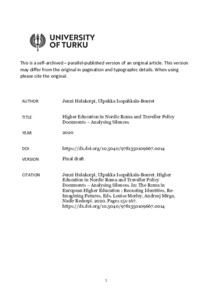Higher Education in Nordic Roma and Traveller Policy Documents – Analysing Silences
Jenni Helakorpi; Ulpukka Isopahkala-Bouret
https://urn.fi/URN:NBN:fi-fe2021042824358
Tiivistelmä
The Nordic countries have national Roma and Traveller policies (MSAH,
2018;
AID, 2009; MSAI, 2011; NOU, 2015; Skr., 2011),
which are constituted in the interplay of national and
international Roma policy processes and Nordic collaboration (see
Helakorpi,
Lappalainen and Mietola, 2020).
However, in the Nordic countries there are no national statistics based on ethnic
or racial identification since the population level statistics are
based on register data in which information
on ethnic and racial identification is not included. No censuses
have been gathered in these countries in decades. Thus, the
overall descriptions of the situation of Roma and Travellers are
based on estimations and small-scale surveys. However, there
are little or no reliable numerical population level estimations.
Nevertheless, it is estimated that the completion of basic
education and attainment to upper secondary education is
distinctively lower in comparison with the rest of the population
(Rajala et al., 2011; Hagatun, 2019; NOU, 2015; SOU, 2010; MSAI, 2011).
In addition,
the current view is that the number of Roma and Travellers
participating or having completed higher education (HE) is significantly
smaller than the national averages (Alexiadou and Norberg,
2015: 19–20; NOU, 2015; Hagatun, 2019;
Rajala and Blomerus, 2015).
The social dimension of HE has been
firmly expressed in European policy declarations for over a
decade. It rests on the idea that students accessing, participating
in and completing HE at all levels should reflect the diversity of
populations (London Communiqué, 2007).
The main purpose of this social agenda is to make HE institutions more inclusive and to widen access to the social privileges that HE offers.
Kokoelmat
- Rinnakkaistallenteet [27094]
